The distance between grape bushes, or is there any point in thickening the plantings?
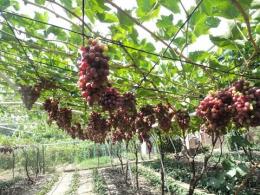
Grape cultivated by man since ancient times, he went through centuries of cultivation experience with him. Using the knowledge of previous generations and the experience of modern winegrowers about growing this berry, it is possible to optimally prepare planting conditions. Including, understand what distance should be between the grape bushes.
Content:
- Plant roots
- Planting density
- Features of planting in greenhouses
- Does it make sense to thicken plantings?
Plant roots
Grape - one of the types of perennial shrub vines. This is a plant with a powerful root system, which can be compared in size to the upper part.
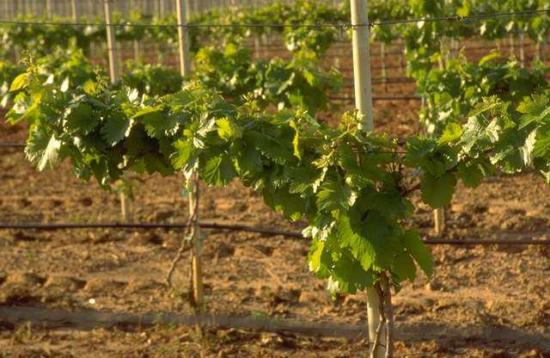
Before planting a vineyard, you need to know:
- Each variety has its own root location
- Root development depends on the type of soil, weather conditions, humidity level
- On average, by the end of the first year of life, the roots spread over a radius of 70 cm in width and 70 cm in depth; in the second year of life, root growth is insignificant
- A three-year-old plant develops soil within a radius of 100 cm wide and 90 cm deep.
- Seven-year-old grapes have roots within a radius of 2.5-3 meters in width, but approximately 75% of the roots are still located within a radius of 60 cm
- The most active part of the roots is the tips, which live for about 20 days, then they are replaced by new ones, which grow further and further in width and depth.
All varieties differ from each other in growth vigor, frost resistance, taste, size, productivity and of course the structure of the root. For example, the American species Riparia prefers more horizontal distribution of the root system in surface soils.
This is due to the fact that Riparia has been growing for centuries on soil that is close to the limestone layer. Accordingly, other conditions will have a different effect on the root system. Loose soil contribute to the rapid spread of roots in all directions; in dry areas, grape roots tend to grow deeper.
In moist, cool soils, the roots lie at a level of 20-40 cm from the surface; in warmer chernozem soils, the depth is closer to the level of 60 cm; in sandy soils, the roots tend to a depth of 150 cm or more.
In some cases, the roots can spread over a radius of 5 meters wide and up to 14 meters deep. The root system adapts well to soil conditions if it is given enough space to do so.
Grape the roots are thin, with an average thickness of 1.5-2 cm. Each root at the very end has many root hairs, thanks to which the main absorption of water and nutrition occurs. This end is called the absorption zone; the poorer and drier the soil, the more developed this zone is.
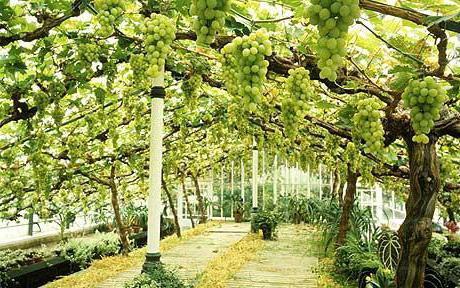
Grape - a perennial crop, on average it lives 75 years. Individual specimens can live 100, 200 or even more years. The oldest vine that still bears fruit is considered to be a vine in Slovenia in the city of Maribor. It was planted in 1580!
To obtain a good harvest, it is necessary to take into account the fact that fruiting depends on how developed the root system is.
Planting density
Usually grape planted in rows - it’s more convenient to tie it to trellises or stakes.The distance between plants in a row and between rows is called planting density.
Ideal parameters: the distance between grape bushes in a row and between rows is 3 meters, and if the site allows, then 3.5.
At this distance:
- Plants will have enough space to develop roots and aerial parts
- It is possible to use a two-plane trellis without a large load on the vines
- The sun will illuminate evenly vineyard – the vines will not shade each other
- Good ventilation is ensured - less risk of disease
When planting a vineyard, it should be remembered that the yield depends to a greater extent on the feeding area, and not on the number of plantings. Subject to optimal conditions, where plants are given plenty of space, the yield will be maximum with the least amount of labor.

However, the conditions of 3 * 3 meters can be changed depending on the variety, soil composition, its nutritional value, location, and row orientation. Strongly growing varieties on fertile soils are planted at a distance of at least three meters from each other, and the row spacing is 4-5 meters. For low-growing varieties, the distance between the bushes can be left 2.5 meters or even 2.3, this will be quite enough for them.
You can increase the distance between the rows, while reducing it between the bushes, but you should not make it less than 1.2 meters. For example, using the 3.5 * 1.5 scheme, the feeding area will be 4.5 meters, which is quite enough for one plant for a long time.
Heavily thickened vineyards develop poorly and require more care. The amount of harvest is less than it could be with a larger feeding area.Over time, part of the vineyard may die in competition for the sun and nutrients in the soil.
Wide planting is most beneficial for table varieties. However, some wine varieties are specially planted close to each other - the distance between plants is sometimes 70 cm, and only one meter between rows. At the same time, a large harvest is rarely harvested from the vine - two to three kg, because there are very few shoots on such a bush.
Features of planting in greenhouses
Grape it is very demanding of light and heat, so in more northern regions some gardeners grow it in greenhouses. Still, open spaces are preferable for any plant, so those who cannot afford to plant grapes in the open air grow in greenhouses. Or lovers of more southern varieties.
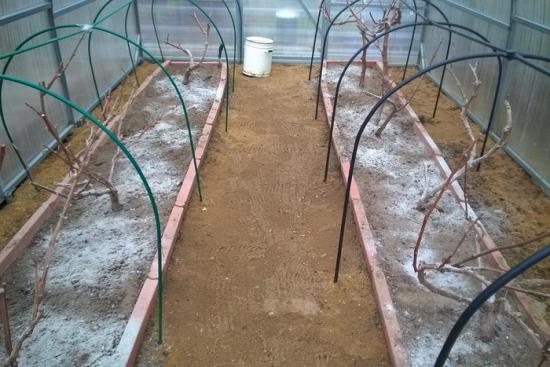
A greenhouse allows you to protect plants from returning spring frosts; in it they begin to vegetate earlier and, accordingly, bear crops earlier. In the fall, the vines have time to ripen and are not afraid to go into winter.
Distance between bushes grapes in the greenhouse is selected depending on the following conditions:
If it is known that varieties winter well in your region, then it is advisable to plant grapes as widely as possible - at least 2 m between rows, at least 1.5 m between bushes;
If it is not known how the variety overwinters, then you need to plant them more densely with further thinning;
The greenhouse should be well ventilated and well lit.
Greenhouses for growing grapes are used not only by gardeners, but even by large agricultural complexes. For example, in China this method is not uncommon. Grapevines are grown in greenhouses not only in the northern regions, but also in the southern deserts.On the Arabian Peninsula it is grown in huge greenhouses over large areas.

The distance between grape bushes when planting in a country house is calculated in the same way as for a regular plot - and the more, the better. By giving the plant more freedom, you give it the prospect of many years of development. At the dacha, the plant can be planted along walls or fences on the south side; the distance between the bushes should be at least one and a half meters.
Does it make sense to thicken plantings?
Let's consider this issue from different points of view, because people made the vineyards thick for a reason, what is the benefit of this? Dense plantings were used by winegrowers before the widespread use of trellises. Previously, stainless steel wire was not so widely available, and the vines were grown on stakes, while they were not able to spread wider. The number of fruiting shoots was small due to this method of cultivation and due to the small feeding area.
Gradually inforeigners began to use trellises, and came to the conclusion that it is more rational to grow one well-developed bush with a large number of shoots, compared to several bushes with fewer.
It was also noticed that more developed bushes better tolerate various unfavorable factors, live longer and bear fruit, compared to their less developed counterparts in dense plantings. In dense plantings, in order to somehow “help” the grapes, they are not allowed to develop powerfully, cutting out most of the shoots. This usually results in the roots not developing to their full potential.

For the first five years, dense plantings show better fruiting results than sparse ones. But in the future, wide planting has advantages both in terms of fruiting and in terms of labor costs.
The most important thing for grapevine - this is air, earth and sun. These conditions are difficult to fully comply with when planting densely. For the first five years, plants can still grow intensively, but then they influence each other more and more, such plants age faster and die.
When the roots of plants fill all the space allotted to them, the development process stops, the soil gradually becomes more and more depleted, which leads to general oppression of the bush.
To have more complete information about the principles of planting and growing grapes, and you can also find out the optimal distance between grape bushes when planting by watching the video:



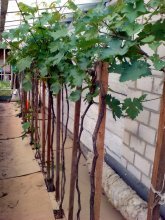

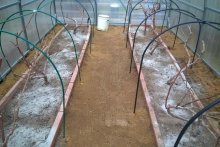
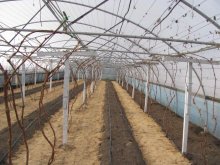




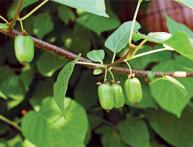



Comments
My grapevine is planted a little denser than recommended and the distance between the rows is 1.2 m. The yield of grapes depends not only on the feeding area, but also on pruning the vine - this is done so that the size of the bunch is optimal and the berries are not small.